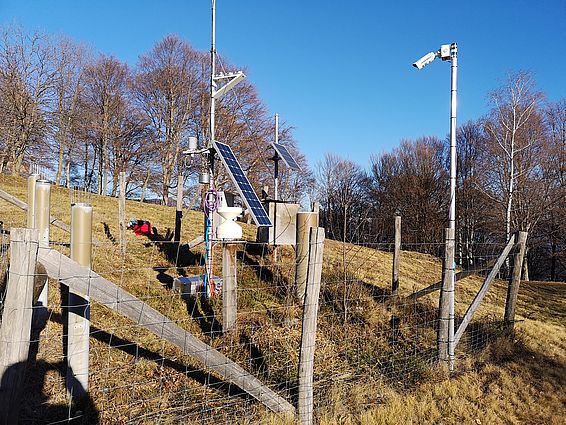28.01.2020 | Reinhard Lässig | News WSL
An additional input of nitrogen stimulates tree growth. However, if the amount of nitrogen entering a forest from air pollution exceeds 30 kilograms per hectare per year, timber growth slows due to a lack of other nutrients needed for growth. This is the finding of a study conducted in 23 European countries and led by the Swiss Federal Institute for Forest, Snow and Landscape Research (WSL).
Until now, forest ecologists and forestry scientists have tended to assume that nitrogen from air pollution generally leads to more timber growth. This nutrient acts like a fertiliser and is an important building block for the growth of plants. However, if the amount of additional nitrogen exceeds certain limits, growth can be inhibited. The actual extent of this inhibition in European forests has not been clear, until now.
To make long-term predictions about how forest ecosystems will respond to environmental alterations such as climate change, it is necessary to understand and be able to assess the main drivers of tree growth and forest development. This prompted an international research team, led by the WSL, to investigate the influence of nitrogen on the growth of trees.
Lack of nutrients despite abundance
The researchers have now shown that the additional growth induced by nitrogen is limited, right across Europe. According to data collected at 442 forest monitoring plots in 23 European countries, tree growth decreases almost everywhere if nitrogen inputs exceed approximately 30 kilograms per hectare per year. Below this limit, nitrogen generally boosts growth. The reason why growth tails off is that sufficient quantities of other important nutrients are missing. Soil acidification is also a factor.
Researchers within the European forest monitoring network ICP Forests (see box) set about investigating this issue across the continent. Between 1995 and 2010, they collected several million pieces of data from around 100,000 coniferous and deciduous trees. They measured the species, height and trunk diameter in these forests, as well as various climatic and environmental factors such as pollutant input from the air and soil quality. They then examined whether different-sized trees showed similar development patterns over the 15-year period. The study included data from spruce, pine and beech trees at Swiss observation plots in Alptal (canton of Schwyz), Beatenberg (Bern), Isone (Ticino), Lausanne (Vaud), Lens (Valais), Neunkirch (Schaffhausen) and Othmarsingen (Aargau).
Nitrogen is the key environmental factor
Despite significant differences in geography, geology, soil, altitude, climate and other environmental factors, the main determinants of the annual increase in tree diameter and height were the number of trees – and therefore the competitive pressure – and the age of the forest stands. This means that the form and intensity of management by forestry services and forest owners have a bearing on timber and leaf-mass growth. However, the most important environmental factor was found to be the amount of nitrogen entering the soil via the air.
For the first time in Europe, the researchers were able to demonstrate that a 'tipping point' occurs at, on average, between 25 and 35 kg of nitrogen input per hectare per year. If the locally determined value is above the tipping point, the trees grow less. This effect was most pronounced in beeches.
In experiments conducted over recent decades, researchers had calculated a nitrogen limit of 10–20 kg/ha/year for Central European forests. However, the two values cannot be directly compared. The latter value relates to long-term increased nitrogen inputs, and not only with respect to tree growth but also other possible impacts such as biodiversity, lichens, fungi and nitrate leaching.
But one thing is certain: too much nitrogen disturbs the nutrient balance in the forest ecosystem. "For decades, researchers have been debating at what point this starts to occur. Working with colleagues from across Europe, we were able for the first time to determine a specific limit for tree growth in both natural and managed forests based on large-scale research," says the WSL's Sophia Etzold, lead author of the study. In all locations, other environmental factors such as air temperature, precipitation and ozone had a smaller impact on tree growth than nitrogen, which today largely originates on farms (in the form of liquid manure, animal feed and artificial fertilisers, for example), with less and less derived from combustion processes. The results suggest that further curbs on nitrogen emissions are needed to prevent global losses in forest growth.
The study uses data and sites from the International Co-operative Programme on Assessment and Monitoring of Air Pollution Effects on Forests (ICP Forests, www.icp-forests.net). This forest monitoring network is run by European countries under a United Nations Economic Commission for Europe (UNECE) convention. The WSL's Long-term Forest Ecosystem Research (LWF) programme is the Swiss contribution to ICP Forests, and the WSL's Marco Ferretti has been the Chairman of ICP Forests since 2017. It is one of the largest networks in the world for observing and monitoring terrestrial ecosystems. Every country across Europe uses comparable methods of sampling and analysis, on a long-term basis. This means that researchers can track – for example – the impact of air pollution on forests, not just in their own country but Europe-wide.
Contact ¶
Links ¶
Publications ¶
Copyright ¶
WSL und SLF stellen Bildmaterial zur Bebilderung von Presseartikeln im Zusammenhang mit dieser Medienmitteilung kostenfrei zur Verfügung. Eine Übernahme der Bilder in Bilddatenbanken und ein Verkauf der Bilder durch Dritte sind nicht gestattet.





